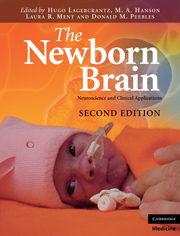Book contents
- Frontmatter
- Contents
- List of contributors
- Preface to the First Edition
- Preface to the Second Edition
- 1 Reflections on the origins of the human brain
- Section 1 Making of the brain
- 2 The molecular basis of central nervous system development
- 3 Holoprosencephaly and microcephaly vera: perturbations of proliferation
- 4 Neuronal migration
- 5 The neonatal synaptic big bang
- 6 Neurotrophic factors in brain development
- 7 Neurotransmitters and neuromodulators
- 8 Glial cell biology
- Section 2 Sensory systems and behavior
- Section 3 Radiological and neurophysiological investigations
- Section 4 Clinical aspects
- Section 5 Follow-up
- Section 6 Consciousness
- Index
- Plate section
- References
2 - The molecular basis of central nervous system development
from Section 1 - Making of the brain
Published online by Cambridge University Press: 01 March 2011
- Frontmatter
- Contents
- List of contributors
- Preface to the First Edition
- Preface to the Second Edition
- 1 Reflections on the origins of the human brain
- Section 1 Making of the brain
- 2 The molecular basis of central nervous system development
- 3 Holoprosencephaly and microcephaly vera: perturbations of proliferation
- 4 Neuronal migration
- 5 The neonatal synaptic big bang
- 6 Neurotrophic factors in brain development
- 7 Neurotransmitters and neuromodulators
- 8 Glial cell biology
- Section 2 Sensory systems and behavior
- Section 3 Radiological and neurophysiological investigations
- Section 4 Clinical aspects
- Section 5 Follow-up
- Section 6 Consciousness
- Index
- Plate section
- References
Summary
Introduction
The aim of this chapter is to discuss how the central nervous system (CNS) is generated during development, and the rapid progress that is made in deciphering the underlying molecular programs for different steps in this process. Particular emphasis will be placed on the discussion of genes that are directly relevant for human CNS malformations.
Morphology of the developing CNS
In humans and other vertebrates, the early aspects of nervous system development proceed through a set of stereotypical intermediate steps. The first signs of the developing nervous system appear on the dorsal side of the gastrula-stage embryo where, in a process called neural induction, the mesoderm induces the overlying ectoderm to form the neural plate or neuroectoderm. The exact mechanism by which the mesoderm influences the ectoderm-to-neuroectoderm transition is still not understood, and hypotheses range from those suggesting the neuroectoderm develops by default mechanisms to those of a more active, instructive role for the mesoderm (see below).
After neuroectoderm formation, the neural plate bends along the rostrocaudal body axis to form the neural groove, and this change in morphology is accomplished by forces exerted through both the neural plate cells and the surrounding epidermis (Fig. 2.1). The notochord induces these cells to decrease in height and to become wedge shaped, giving rise to the neural groove (van Straaten et al.,1988; Smith & Schoenwolf, 1989). Shortly thereafter, the edges of the neural plate thicken and move upward to form the neural folds.
Information
- Type
- Chapter
- Information
- The Newborn BrainNeuroscience and Clinical Applications, pp. 23 - 36Publisher: Cambridge University PressPrint publication year: 2010
